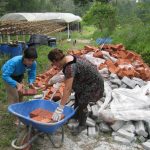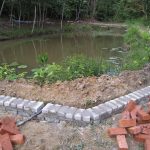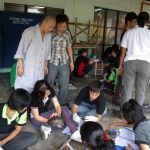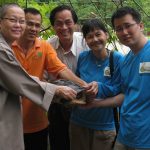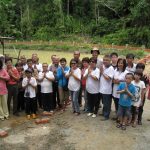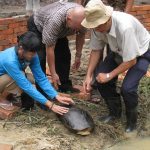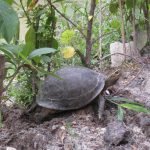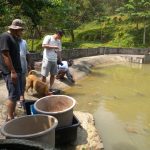Turtles from the Sam Poh Tong Temple given a new home

When my friend Doris, a most compassionate Buddhist contacted me in December of 2010 to help find a new home for the 100 odd turtles kept in a concrete pond in the Sam Poh Tong Temple in Ampang, I had wholeheartedly agreed to help. At that time, I had no idea where those turtles could be relocated to.
My reasons for wanting to help were manifold. I love turtles and I will do all I can to help save them and to enable them to lead a natural, healthy and happy life.
Turtles are wild animals that require natural but specific habitats so that they can forage for food, mate and reproduce. Some turtles live in the water while some are terrestrial, meaning they live on land. There are also some that are semi-aquatic. If you force a terrestrial turtle into a concrete pond with no chance of escape, the turtle will ultimately die, and vice versa. All turtles, be they aquatic or terrestrial, lay their eggs on land where soil or sand provide the correct conditions for the eggs to develop.
When turtles are kept in small concrete ponds, they live in very hard and artificial conditions. They suffer but have no voice to complain about the life-long imprisonment they have been forced into. Frequently they are fed the wrong kinds of food and suffer from malnutrition that is manifested in deformities in the shell (calcium deficiency) and other parts of the body. Calcium deficiency also results in eggs with thin or poorly formed eggshells. Such eggs will not be viable.
Some species of turtles are herbivorous (i.e they eat vegetable matter), some are carnivorous (meat-eating) while others are omnivorous (eating a mixture of plants and animals). It is important to find out the feeding habits of turtles that are kept in captivity in order to provide them with the right kinds of food.
Turtles, like many other wild animals, are endangered. They have been exploited by mankind for many decades to the extent that many species are now in danger of extinction. The major threat facing the non-marine species of turtles today is illegal trade. There is a huge demand for them especially in China where the turtles fetch a high price and are sought after as a culinary delicacy and for their medicinal value. To fuel this demand, poachers have mined the natural habitats of turtles in Asia and smuggled tens of thousands of turtles to China. A local demand exists as well where the turtles are caught and delivered to dealers or direct to restaurants for consumption. There is also a significant demand for these turtles for the pet industry.
A good proportion of the turtles are caught and sold to Buddhists for “fangsheng” or life liberation. However, the noble value in this practice is lost in modern times and has unwittingly caused hardship and certain death to many species of animals that are released. Let me elaborate:
The popularity and in some cases, institutionalized and regular practice of “fangsheng” has created a huge demand for animals to be released. To meet this demand, many species of animals are captured, kept in crowded conditions by wholesalers, then sent to retailers who sell the animals to individual Buddhists or Buddhist organizations. Many of the captured animals die before they are due for release and often those that survive and are ultimately released are recaptured by the traders. The animals are frequently released into habitats that are unnatural or unsuitable for the animal’s well-being and needs. Therefore, instead of being kind to the animals, this practice of “fangsheng” has brought hardship to them, and in many cases, certain death.
Apart from the well-being of the animals released, the health of humans involved in the release is also at risk. Animals, especially birds can transmit diseases such as avian flu to humans. One can imagine how easily the virus can spread from one region to another when birds are captured for release from distant regions.
Unknown to most laymen, “fangsheng” has been responsible for the introduction of invasive or non-native species to local habitats. If the local habitat is unsuitable, the animal released will not survive. However, the introduced species can adapt to the local environmental conditions, become very successful and possess the potential to wipe out local species. Introduced species also introduce pathogens to local species.
Another consideration is the legality of buying and possessing of animals for release. Most of our country’s turtles are protected under the Wildlife Conservation Act that came into effect in 2010. If caught in possession of the animals without a permit, a hefty fine, or jail term or both may be imposed.
Coming back to the story of the Sam Poh Tong Temple turtles, a preliminary visit confirmed the presence of four species of turtles, one of which was a non-native species. There was one Malaysian Giant Turtle, three Black Marsh Turtles, 56 Asian Box Turtles and 48 Red-Eared Sliders, the non-native species, giving a grand total of 108 individual turtles kept in the concrete pond. As the pond was shallow the small quantity of water heated up quickly in the hot weather and most times, the turtles crawled out to seek refuge under some zinc sheets.
The most tricky part was finding a suitable place to house the turtles. The non-native ones have to be confined so that they do not escape into the wild under any circumstance. The search was good for me as I ended up reconnecting with an organic farmer friend, Dr. Ng Poh Kok whom I had more or less lost touch with. I also worked with Loretta Shepherd who invited Drs Reuben Sharma and Sumita Sugnaseelan (vets who are also a veterinary science lecturers at Universiti Putra Malaysia) to assess the health condition of the turtles prior to release. The health assessment was particularly valuable, not only for the obvious benefit of the turtles, but it was a hands-on experience for 27 veterinary students and 4 volunteers who assisted in the 6-hour long operation.
After many discussions and visits to Dr. Ng’s Organic Park in Batu Arang and the Bentong Farm Sanctuary (BFS) in Pahang, it was decided that the native species will be released into Dr. Ng’s park while the non-native species, the red-eared sliders would go to the BFS.
We had to build a concrete fence around the large pond in the organic park to prevent the turtles from escaping into Dr. Ng’s organic vegetable plots. This was a costly and time consuming task, but thanks to Dr Ng’s workers and funds donated by the Sam Poh Tong Temple, Lim Puay Aun, Chan Kean Eng and Chan Eng Heng, the fence was completed in time for the release that took place on 1 May 2011.
The release was a most joyous event shared by about 30 people, most of whom were devout Buddhists. Two weeks later, on the 15 May 2011, Loretta and five volunteers released the non-native species, i.e. the red-eared sliders into a spacious pond the Bentong Farm Sanctuary. Simple basking platforms will need to be added to this pond to make it more suitable for the turtles.
The photographs provided capture some of the memorable moments of this meaningful relocation of the temple turtles to ponds and habitats that are more natural and suited to their needs.
Acknowledgments
I would like to thank Reverend Sing Kan, Dr. Ng Poh Kok, Bentong Farm Sanctuary, Loretta Shepherd, Brother How, Doris, Lim Puay Aun, Chen Pelf Nyok, Chan Kean Eng, Dr Reuben Sharma, Dr Sumita Sugnaseelan, Universiti Putra Malaysia veterinary students, Chi Too, Shahrul Anum Baharin, Chris R. Shepherd, Olivier Caillabet, Suzalinur Manja Bidin, Kaitlyn Foley, Nurul Bariyah and Mohd. Azizi for their help and collaboration in making a success of the relocation exercise.
Photo credits : Chan Eng Heng, Lim Puay Aun, Loretta Shepherd.
- concrete pond where the turtles were housed in the temple
- The turtles often sought refuge from the heat under some zinc sheets
- Hands-on involvement in getting the large mud pond ready for the turtles
- Hands-on involvement in getting the large mud pond ready for the turtles
- Vets and Vet students from UPM examining the turtles.
- Symbolic handing over of the turtles for relocation
- Buddhists and volunteers involved in the relocation
- The large mud pond provides a more natural living environment for the turtles
- Turtles being released
- The largest was the last to go
- This turtle was seen trying to dig an egg chamber soon after it was released
- Release of the red-eared sliders into the Bentong Farm Sanctuary



